

Steve Kirk: Teaching ‘EAP’: Enabling Academic Participation, E-merging Forum 5. 7 Ways to use Google Docs in the EAP Classroom. What is a Google Doc and why might we want to use it in the EAP classroom?
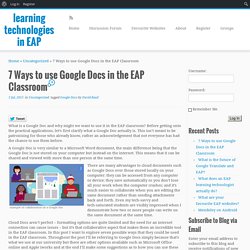
Before getting onto the practical applications, let’s first clarify what a Google Doc actually is. This isn’t meant to be patronising for those who already know, rather an acknowledgement that not everyone has had the chance to use them before. A Google Doc is very similar to a Microsoft Word document, the main difference being that the Google Doc is not stored on your computer but instead on the internet. This means that it can be shared and viewed with more than one person at the same time. BERAUK sur Twitter : "How researchers continue to put one over teachers in the HE promotion stakes - a new Blog from James Derounian.
The Cultures of EAP: Celebrating and Exploring Diversity - Events - ELTC - The University of Sheffield. Master in English for Specific Purposes (60/120 credits) - Linnaeus University, Sweden - Lnu.se. There is a great need for language experts in different professional areas.
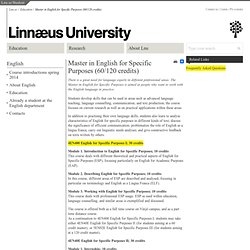
The Master in English for Specific Purposes is aimed at people who want to work with the English language in practice. Students develop skills that can be used in areas such as advanced language teaching, language counselling, communication, and text production; the course focuses on current research as well as on practical applications within these areas. In addition to practising their own language skills, students also learn to analyse characteristics of English for specific purposes in different kinds of text; discuss the significance of efficient communication; problematize the role of English as a lingua franca; carry out linguistic needs analyses; and give constructive feedback on texts written by others. 4EN400 English for Specific Purposes I; 30 credits.
Using English for Academic Purposes. I have spent most of my life teaching ESP & EAP and in talks that I have given and courses that I have run, I’ve always given two strong reasons for teaching ESP or ESAP as opposed to general English or EGAP.
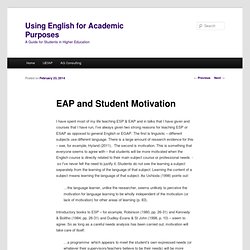
The first is linguistic – different subjects use different language. Innovation in EAP. It’s already a week now since the in EAP Conference – Innovation: The Key to the Future that took place at the University of St Andrews.

I had the privilege to attend the event with two other members of staff from the English Language Teaching Unit at the University of Leicester and the other lucky delegates who came from all over the country, and even from as far as Japan, to gorgeous St Andrews, in Scotland. I was there mainly to present on TEAP, the distance learning postgraduate degree programme to train teachers of general English to become tutors of English for Academic Purposes. 10 point guide to dodging publishing pitfalls. Sue Kay and Karen Spiller: ELTC at the University of Sheffield: Teacher Development Down (in?) the Toilet. In a previous post, I talked about how our school has developed these scholarship circles on a variety of topics to give teachers time to develop both themselves and the centre.

Now, the Teacher Development circle (of which I’m a part) recently discussed the issue of how we can constantly provide teachers with new ideas and activities to take in their classrooms. In the past various things had been tried. Interesting journal or website articles were sent round via email, or they were stuck to various notice boards around the staffroom and teacher offices. Useful ideas and activities were also posted on our internal website. English-Language Learners and Academic Language. Editor's Note: This blog was co-authored by Katie Hull Sypnieski.
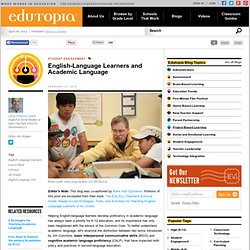
Portions of this post are excerpted from their book, The ESL/ELL Teacher's Survival Guide: Ready-to-Use Strategies, Tools, and Activities for Teaching English-Language Learners of All Levels. Helping English-language learners develop proficiency in academic language has always been a priority for K-12 educators, and its importance has only been heightened with the advent of the Common Core. To better understand academic language, let's examine the distinction between two terms introduced by Jim Cummins, basic interpersonal communicative skills (BICS) and cognitive academic language proficiency (CALP), that have impacted both policy and practices in second-language education:
A Tale of Two Writing Centers in Namibia: Lessons for Us All. Supporting the Neophyte Writer: The Importance of Scaffolding the Process. Journal of Academic Writing. The Education Scientist: Khan Academy: The Illusion of Understanding (Part 1) Guest blog by Dr.

Marc SchwartzProfessor of Education at the University of Texas at ArlingtonDirector of the Southwest Center for Mind, Brain, and Education This post is based on an article by the same name published in the Journal of Asynchronous Learning Networks. Good academic writing – it’s about revision not editing. Creative writers are accustomed to the idea that their writing must go through several drafts.

However, much of the advice on offer to academic writers proceeds as if all they have to do is produce a draft which is then edited, tidied up, everything made neat and clean. I have seen many a thesis completion timetable come unstuck because doctoral researchers have not grasped the fact that by and large this is not what happens. Most of us have to do more than one draft of a piece of academic writing. In reality, very few of us write the scintillating introduction, the elegant conclusion, the persuasive argument right from the start. It takes several iterations.
Twitter journal: would you share your original research on social media? Last week, I received a tweet from @janremm who was midway through a conversation – on Twitter – about how to cite tweets within academic research.

She was talking with @jotaigna, who asked in what way a tweet could be a valuable source to support a (scientific) argument. I think it's fair to say he was sceptical. But why couldn't this be possible? How to shine in an academic interview. Many dread going to job interviews.
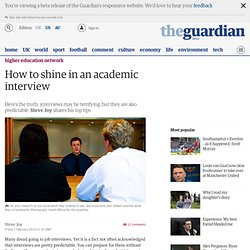
Yet it is a fact not often acknowledged that interviews are pretty predictable. You can prepare for them without feeling as if you are submitting to a dark ritual in the face of which passive acceptance is the only option. My aim is to point out some of the thinking behind interview questions, and a few ideas for practical ways that you can prepare. Talk to others about their interview experiences. UK universities – it's time to go to India. UK universities must go to India if they are to benefit from a shake up to international higher education which will see India enrolling the largest number of students into tertiary education in the world by 2020, warns a British Council report.
Universities are being urged to move away from focusing on recruiting Indian students to forming partnerships in India, creating new opportunities for UK students and academics to study and teach there, as well as encouraging collaboration through research. "By 2020, India and China will produce 40% of the world's graduate talent pipeline," says Lynne Heslop, British Council's senior education advisor in India and author of the report. "We can't sit back and rely on this talent to continue coming to the UK. "Other countries are also looking to capitalise on these new opportunities, and the UK will miss out unless our sector can increasingly engage with India, in India.
" Yet collaboration in India won't come without its challenges. Our 14.28% Time. Famously, Google have a system within their company called 20% time which gives their employees space to develop their own ideas and projects, many of which - e.g. Gmail - actually became full-blown services. There have been rumours that this is disappearing, but regardless, it’s a principle that’s been picked up in education and now many teachers give their students free time during the week to allow them to develop their own creative projects. There are even communities on social networks that teachers can join to share their experiences and ideas for how to implement it in the classroom.
But what about us teachers? Let's stop the 'hero worship' when it comes to big name academics. PhD students and professors sometimes betray a certain infatuation with the "big names" of academia. It goes beyond admiration into the realm of hero worship, and it's a bit silly. We're getting too old for it. Especially by the time the dissertation has been written. Shouldn't we expect a measured nonchalance toward the whole notion of big names and so-called great ideas? Plus.google. EAP Teacher Survey. Britain wants you! Why the UK should commit to increasing international student numbers. How can cutting net migration be squared with strengthening the UK’s position as a leading destination for international students?
This report reviews the effects of the Coalition government’s policies on the international student visa regime and their wider impact on the education sector, sets out the best available data and evidence on student migration to the UK, and recommends more effective approaches to growing and overseeing our international education sector. Google Scholar Library. International students: how to teach them alongside native speakers.
As I stood with a professorial colleague outside a coffee shop on our London campus one November morning, a group of Chinese students spotted me and ran in our direction. Each took off one glove and threw it at my feet.
EAP Assessment. Raising awareness of best-practice pedagogy. E-AP. EAP Events. EAP Practitioner Development. EAP Tools & Resources. EAP Communities.